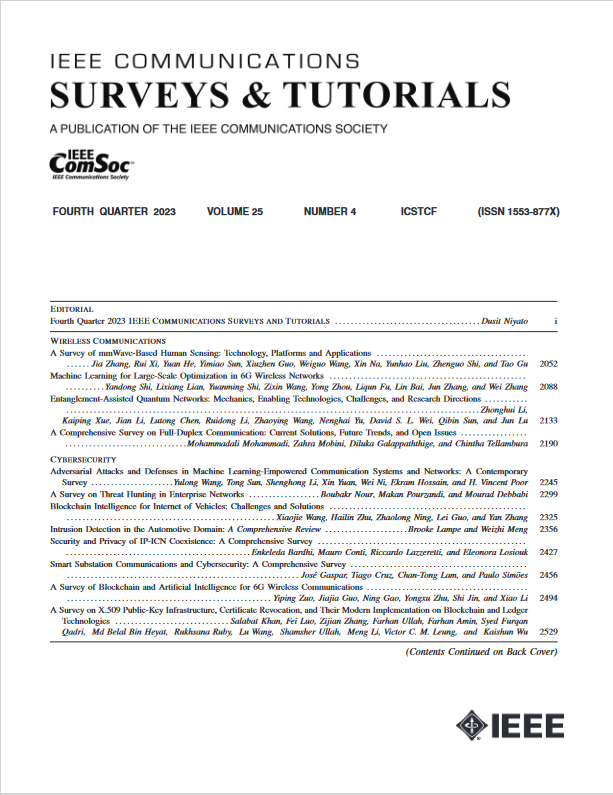水下无线传感器网络信任管理设计指南
IF 34.4
1区 计算机科学
Q1 COMPUTER SCIENCE, INFORMATION SYSTEMS
引用次数: 0
摘要
近年来,水下无线通信和声学传感器技术取得了长足进步,推动了对海洋丰富自然资源的探索和利用。水下无线传感器网络(UWSN)越来越多地部署在无人值守的恶劣环境中,这就要求采取强有力的安全措施。安全的通信环境对于包括海岸防御、水下通信和海洋勘探在内的一系列 UWSN 应用至关重要。信任模型已成为一种有效的安全机制,用于评估 UWSN 中单个节点在受到不利攻击时的可靠性。与无线传感器网络(WSN)不同的是,UWSN 会遇到独特的挑战,包括有限的资源、恶劣的水下条件和不可靠的声学通信,因此建立一个可靠的基于信任的系统至关重要。在本文中,我们回顾了有关 UWSN 安全的现有工作,讨论了安全和信任挑战,并探讨了基于信任的应用。此外,我们还评估了近年来适用于 UWSN 的各种信任模型,对加权和方法、基于逻辑的技术、概率和统计模型以及机器学习范例等方法进行了分类和比较。最后,我们讨论了 UWSN 信任管理的当代挑战和未来方向。通过对信任管理方法进行系统的概述和分类,本文有助于理解和开发适用于 UWSN 的有效信任机制,最终提高其可靠性、安全性以及在各种海洋应用中的成功运行。本文章由计算机程序翻译,如有差异,请以英文原文为准。
Design Guidelines on Trust Management for Underwater Wireless Sensor Networks
In recent years, significant advancements in wireless underwater communication and acoustic sensor technology have spurred the exploration and utilization of the ocean’s vast natural resources. underwater wireless sensor networks (UWSNs) are increasingly deployed in unattended and hostile environments, demanding robust security measures. Secure communication environments are essential for a range of UWSN applications, including coastal defense, underwater communication, and marine exploration. Trust models have emerged as effective security mechanisms to assess the reliability of individual nodes in UWSNs during adverse attacks. Unlike Wireless Sensor Networks (WSNs), UWSNs encounter distinct challenges, including constrained resources, harsh underwater conditions, and unreliable acoustic communication, making it crucial to establish a reliable trust-based system. In this paper, we review existing work on UWSN security, discuss security and trust challenges, and explore trust-based applications. Furthermore, we evaluate diverse trust models suited for UWSNs of recent years, categorizing and comparing approaches like weighted sum methods, logic-based techniques, probability and statistics models, and machine learning paradigms. Finally, we discuss contemporary challenges and future directions in UWSN trust management. By offering a systematic overview and classification of trust management approaches, this paper contributes to the understanding and development of effective trust mechanisms for UWSNs, ultimately enhancing their reliability, security, and successful operation in diverse marine applications.
求助全文
通过发布文献求助,成功后即可免费获取论文全文。
去求助
来源期刊

IEEE Communications Surveys and Tutorials
COMPUTER SCIENCE, INFORMATION SYSTEMS-TELECOMMUNICATIONS
CiteScore
80.20
自引率
2.50%
发文量
84
审稿时长
6 months
期刊介绍:
IEEE Communications Surveys & Tutorials is an online journal published by the IEEE Communications Society for tutorials and surveys covering all aspects of the communications field. Telecommunications technology is progressing at a rapid pace, and the IEEE Communications Society is committed to providing researchers and other professionals the information and tools to stay abreast. IEEE Communications Surveys and Tutorials focuses on integrating and adding understanding to the existing literature on communications, putting results in context. Whether searching for in-depth information about a familiar area or an introduction into a new area, IEEE Communications Surveys & Tutorials aims to be the premier source of peer-reviewed, comprehensive tutorials and surveys, and pointers to further sources. IEEE Communications Surveys & Tutorials publishes only articles exclusively written for IEEE Communications Surveys & Tutorials and go through a rigorous review process before their publication in the quarterly issues.
A tutorial article in the IEEE Communications Surveys & Tutorials should be designed to help the reader to become familiar with and learn something specific about a chosen topic. In contrast, the term survey, as applied here, is defined to mean a survey of the literature. A survey article in IEEE Communications Surveys & Tutorials should provide a comprehensive review of developments in a selected area, covering its development from its inception to its current state and beyond, and illustrating its development through liberal citations from the literature. Both tutorials and surveys should be tutorial in nature and should be written in a style comprehensible to readers outside the specialty of the article.
 求助内容:
求助内容: 应助结果提醒方式:
应助结果提醒方式:


